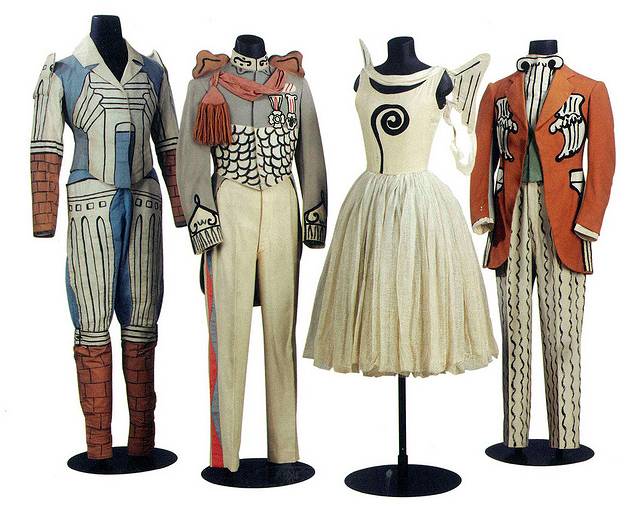This is the final post in my Diaghilev’s Ballet Russes Series. We will look at the intriguing costumes of Le Bal by designer Chirico.
The intrinsic qualities of the Ballet Russes started to change noticeably during the war. Exoticism slowly began to be replaced by Modernism. By the mid 1920’s, the influence of Parisian artists on Diaghilev had helped change the character of the company. Le Bal (The Ball) was one of Diaghilev’s Ballet Russes final productions. Not more than a few weeks after the curtain fell on The Ball, Diaghilev became gravely ill and passed away while holidaying in Venice. (NGA, 1998)
The costume and set designer for The Ball was Giorgia de Chirico and choreography was by George Balanchine. The scenario was that of a masked ball however, the guests at the ball are costumed in a most unconventional way. They all have elements of artificial structures resembling pillars or bricks and mortar together with natural elements of water and wind painted or appliquéd onto their costumes. This gave the impression of moving pieces of architecture. Much of the success of this ballet has been credited to Chirico’s costume and set design. This production launched a successful career in theatre design for Chirico. (Healy & Lloyd, 1990)

There was one exception to the architectural characterisation; the role of the young officer was by contrast quite normal. He wore a stylised military uniform. The cream woolen jacket of this costume had large appliquéd medals with braid detailing. The maroon woolen epaulets are oversized and are believed to be internally structured with a hessian type of fabric that has been stiffened with glue. (Healy & Lloyd, 1990) It has a Chinese stand collar with white appliqué detail. The waistband has red wool appliqué detail and below that is a knife pleated skirt. The jacket secures with hooks and bars at the centre front but has large faux buttons as a design element.
(NGA, 2011) (NGA, 2011) (Schouvaloff, 1997)
The costume for a male guest consists of cream trousers with painted wavy lines representing water. The woolen terracotta frock coat has traditional Doric style columns painted/appliquéd on both sides from the waist down. At the centre back between the Doric columns is a pattern of bricks. There is a faux light green barathea (a soft fabric with a twill weave) waistcoat. This is sewn as part of the jacket, as is often done in ballet costuming. Very cleverly, there is an appliquéd Ionic column where one would expect a cravat to be.
(NGA, 2011) (NGA, 1998)
Here are just a couple of examples where Ballet Russes costumes have obviously been used to inspire a fashion collection. These two examples are from Olympia Le-Tan’s 2015 Fall Collection.
(Olympia Le- Tan, 2015)
After Diaghilev’s death, the company disbanded. Although a number of new companies were formed and carried on some of the most popular works. One of these was the Ballet Russes de Monte Carlo. They had access to many of the sets and costumes and were able to revive more than twenty ballets from the Ballet Russes Repertoire.
Many of Diaghilev’s dancers and choreographers formed companies; George Balanchine – New York City Ballet, Ninette de Valois – Royal Ballet, Serge Lifar – Paris Opera Ballet, Marie Rambert – The Ballet Rambert are some examples. Perhaps we will never know how much of Diaghilev’s influence has helped make modern ballet what it is today? I believe the legacy of his vision of collaboration between the arts lives on!
References:
Healy. R & Lloyd. M (1990) From Studio to Stage. Canberra: Publications Department, Australian National Gallery.
National Gallery of Australia. (2011). Ballet Russes The Art of Costume. Retrieved from National Gallery of Australia Website: http://nga.gov.au/exhibition/balletsrusses/Default.cfm?IRN=202245&BioArtistIRN=19455&MnuID=3&GalID=5&ViewID=2
National Gallery of Australia. (1998) From Russia With Love. Canberra: Publications Department, National Gallery of Australia
Olympia Le- Tan, (2015). Fall Collection. Retrieved from: http://www.olympialetan.com
Schouvaloff, A. (1997). The Art of Ballet Russes. London: Yale University Press
































